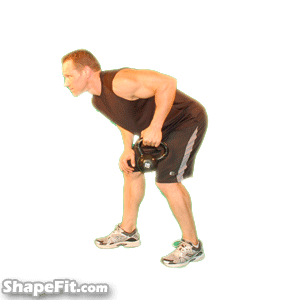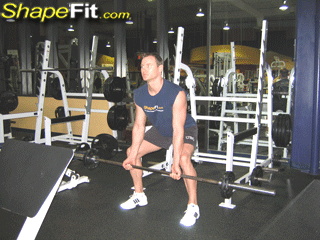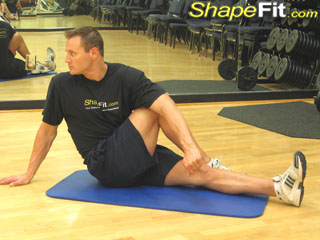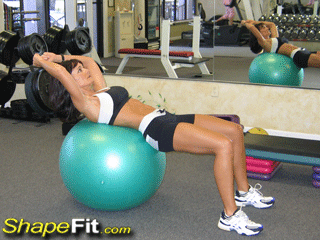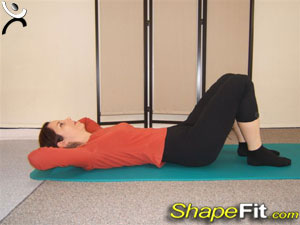Decline Abdominal Crunches – Abs Exercise Guide with Photos
Muscles Targeted: Decline abdominal crunches target the rectus abdominis, or abdominal muscles. In addition, you will work your hip flexors as a secondary muscle.
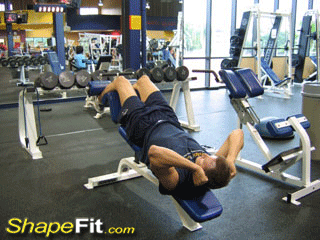
Exercise Instructions: Using a decline bench, position yourself with your feet locked in at the top. Place your hands on either side of your head, without locking your fingers. Raise your body slowly while you contract your abs. Crunch up, bringing your elbows to either side of your thighs. At the top of the movement, flex your abs for a one-count and then slowly lower your body back down to the starting position. Be sure to keep at least an inch or two of space between your back and the bench at the bottom of the movement. For more intensity, hold a weight plate across your chest for added resistance.
Why This Exercise is Important: The decline abdominal crunch is a great way to build strength and definition in the abs. If you are looking to improve your core muscles and get closer to a six pack, this is the perfect exercise to use. When you compare the decline abdominal crunches to other ab exercises, you will notice how much more intense the process is. This is primarily due to the fact that you must rely on your abs to push your body up off the declined bench. In a regular sit up position, or while doing bicycle crunches, it is easier to use your body’s momentum to get the job done. With the decline abdominal crunches, you get a true idea of how strong your abdominal muscles really are.
Exercise Tips: Make sure to squeeze your AB muscles as much as you can when you are at the top of this exercise, because it will result in the maximum contraction. If you feel as though the exercise is getting too easy, you might want to add extra weights. Hold a 5-10 pound weight plate across your chest, and complete the same reps you normally would. Increasing the amount of weight you hold every few weeks will maintain the level of difficulty and ensure your abs are strengthened.
Things To Avoid: Too many individuals use their body’s momentum to perform the decline abdominal crunches, but that should be avoided as much as possible. Instead, you should raise and lower your upper body under the control of your abdominal muscles. This will work your rectus abdominis to the maximum, and ensure you get the most benefit out of the exercise. Perform the decline abdominal crunches on a decline bench, and adjust the bench’s decline until you are getting the maximum tension in your AB muscles while completing the movement. Be sure to control your breathing when you are performing the exercise. When you raise your body off the declined bench, breathe out and exhale. As you are lowering your body back into the decline position, inhale and breathe in. Instead of focusing on the intensity of the exercise or the stress in your abs, focus on each breath you take. Concentrating on your breathing will also allow you to perform more repetitions without stopping.
Reps and Sets: Try to perform 3 sets of 20 or 25 repetitions of the decline abdominal crunches. If you feel as though you are not struggling to complete the last few reps, add five more reps to your set, or add a weight plate for additional resistance.
Other Exercises To Use: If you do not feel comfortable with the decline abdominal crunches, or you want to try a different exercise for variety then you can use different movements. The reverse abdominal crunches, abdominal flutter kicks and medicine ball leg raises are all great exercises to use in your AB workouts. Each of these exercises will work your abs in a similar manner, so long as they are performed correctly. View our extensive database of exercise guides for a comprehensive list of exercises that target the abs.
-
Hanging Knees To Head Raises – Abs Exercise Guide
A very challenging and tiring exercise, the hanging kn
-
Dumbbell Concentration Curls – Biceps Exercise Guide
Muscles Targeted: Dumbbell concentration curls is an e
-
The 10 Underrated Exercises You Need to Try
The 10 Underrated Exercises You Need to Try Are you getting bored
-
Jumping Lunges – Bodyweight Cardio Exercise Guide with Photos
Muscles Targeted: The primary muscles targeted with ju
-
Double Leg Kicks – Pilates Exercise Guide with Photos
Pilates Exercise Instructions: Lie on stomach, engage
-
Dumbbell Lunges – Quadriceps Exercise Guide with Photos
Exercise Advice: Stand up straight and hold a dumbbell
- DON'T MISS
- Palms Down Dumbbell Wrist Curls – Forearm Exercise Guide
- Dips – Triceps Exercise Guide with Photos and Instructions
- Ab Crunches – Medicine Ball Exercise Guide with Photos
- How Long Will It Take For Exercise Results?
- Pushups – Chest Exercise Guide with Photos
- Double Leg Stretch Intermediate – Pilates Exercise Guide
- Exercises for Losing Weight
- Extension – Pilates Exercise Guide with Photos
- Lying Tricep Extensions – Kettlebell Exercise Guide with Photos
- The Ultimate BOSU Total Body Blast Workout
